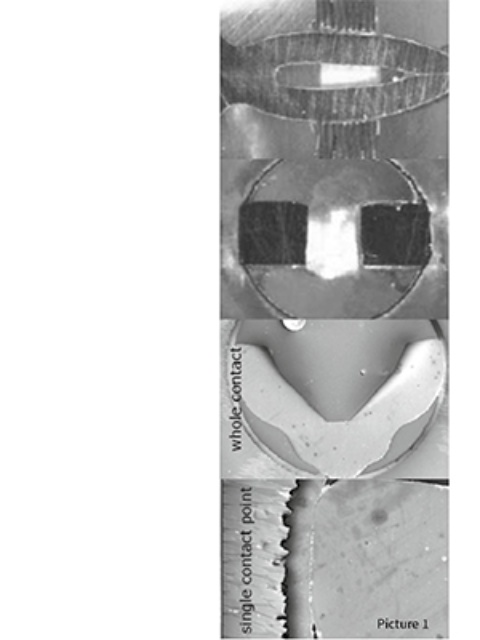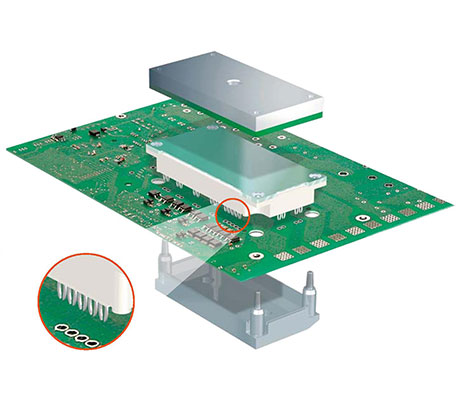PressFIT
Our established, reliable PressFIT mounting technology
Our established PressFIT technology offers the possibility for reliable, solder-less mounting of power modules, meeting the nowadays demands of lead-free technology. According to the RoHS directive, since 2006 most lead-containing solder alloys have to be replaced by lead-free solders. This results in higher melting point solders and lead-free tin metallization of the PCB, which has significant effects on the mounting process.
PressFIT technology is one time-saving possibility for lead-free solderless mounting of power modules. The low electrical and thermal contact resistance makes the contact suitable for a wide range of currents and applications. Environmental tests show that vibration loads and climate sequences have no negative influence on the contact resistance. This results from the gas-tight contact and high contact force. The high holding forces of the contact are independent of the PCB hole tolerances. This reduces the effort for mechanical fixing.

SEM micrograph from a cross section of well-merged surfaces in a force-fitting connection

Usually if two contact faces are assembled, there are only a few spots which are really connected (metal to metal) and which carry the current – this is also true for polished surfaces. The minimum radius of such a microscopic metal-metal contact is typically 10 µm. In force-fitting technologies like PressFIT, there is always a necessary plastic deformation on these truly effective contact points within the contact zone. The contact radius increases due to the high contact pressure that occurs since the macroscopic contact force concentrates on a small microscopic contact area. That means the two faces will be merged.
Thus, the effective contact zone will be increased and – most importantly – a gas-tight contact zone is generated, which is very robust against corrosive environments. The connection principle is the well-known cold welding effect. Here, free electrons are generated from the plastic deformation of both contact faces. The metal-bond electron cloud links the free electrons and connects them again with the same mechanism as in the basic metal. The bonding force is indeed lower than in the prior grid, but is increasing within the first hours of the connection due to recrystallization effects. Cold welding is not suitable for detachable contacts (e.g. bonding of relay contacts) but is well suited for permanent contacts, where the requirements regarding reliability are ofen much higher.
Quality of PressFIT modules
Several tests regarding the application of the PressFIT technology and its reliability in power modules have been performed according to the well-known IEC standards (e.g. IEC 60352-5), but with enhanced conditions. The result of the whole program can be concluded as follows: Not one of the tests caused any measurable contact degradation. The resistance of the connection, which is the leading indicator for the quality of the connection, is very stable during and afer several loadings. This means not only that high current can be handled safely over the lifetime, but also the advanced integrated functions with low voltage and current (e.g. current sensing) will be kept absolutely stable beyond the lifetime of the system. Due to this, the PressFIT technology is well suited to power semiconductor modules – especially for future high-reliability requirements.
| Key features | Applications |
|
Established mounting solutions
| Type of connection | Conductor cross-section in mm2) | Failure rate λref in FIT1) | Notes: Standards/Guide |
| Solder manual |
0.5 0.03 |
GIP 6102) class 2 | |
| Wire bond hybrid circuits Au |
0.1 0.1 |
28μm / Wetch - Bond 25μm / Ball - Bond |
|
| Wire-wrap | 0.05 to 0.5 | 0.002 | DIN EN 60352 - 1 / IEC 60352 - 1 CORR1 |
| Crimp manual, machine | 0.05 to 300 | 0.25 | DIN EN 60352 - 2 / IEC 60352 - 2A 1+2 |
| Termi-point | 0.1 to 0.5 | 0.02 | DIN 41611-4 |
| Press in | 0.3 to 2 | 0.005 | IEC 60352-5 |
| Insulator displacement | 0.05 to 1 | 0.25 | IEC 60352 - 3. IEC 60352 - 4 |
| Screw | 0.5 to 16 | 0.5 | DIN EN 60999 - 1 |
| Clamp (elastic force) | 0.5 to 16 | 0.5 | DIN EN 60999 - 1 |
1) 1 FIT equals one failure in 109 component hours 2) Acceptability of Printed Board Assemblies




